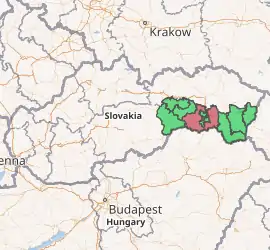Košice-okolie District
Košice–okolie District (okres Košice–okolie; Hungarian: Kassa-vidéki járás) is a district in the Košice Region of eastern Slovakia. It surrounds the city of Košice, which serves as the district seat although it does not belong to the district.
Košice–okolie District | |
|---|---|

| |
| Country | Slovakia |
| Region (kraj) | Košice Region |
| Area | |
| • Total | 1,533 km2 (592 sq mi) |
| Population (2001) | |
| • Total | 106,999 |
| • Density | 70/km2 (180/sq mi) |
| Time zone | UTC+01:00 (CET) |
| • Summer (DST) | UTC+02:00 (CEST) |
| Telephone prefix | 55 |
History
The Košice–okolie district was a part of Great Moravia until the 10th century. After the district fell apart, the area was incorporated into Abaúj and Torna, which were counties of the Kingdom of Hungary.
The region was a part of Abaúj-Torna County from 1882 until the end of World War I. It then became part of the newly formed Czechoslovakia.
Excluding a small section in the north, the district formed a part of Abovsko-turnianská župa of the county of Šariš from 1918 to 1923. From 1923 to 1928, the Košice–okolie district was considered to be a part of Košická župa. From 1923 to 1938, the district was considered to be Slovak land. After the First Vienna Award in 1938, the district was divided between the Kingdom of Hungary and the Slovak Republic, a client state of Nazi Germany. After World War II, the region became known as the district of Košice-vidiek, which is part of Košický kraj. The district of Košice-okolie was established in 1997.[1]
Demographics
According to the Population and Housing Census, the population in 2011 numbered 119,227. 50.3% of the population is female and 49.7% is male. 20.0% of the population is below the age of 15; 69.5% is between 15 and 65 years of age and 10.5% is 65 or older. The main religious affiliations are Roman Catholic (68.3%), Calvinist (6.3%), Greek Catholic (3.9%) and Evangelical (3.4%). A further 5.5% are atheists and 11.2% are of unknown religion.
74.0% of the population are considered ethnic Slovak, 9.9% are Hungarian, 6.5% are Romany and 8.5% are of unknown ethnicity.[2]
Municipalities
- Bačkovík
- Baška
- Belža
- Beniakovce
- Bidovce
- Blažice
- Bočiar
- Bohdanovce
- Boliarov
- Budimír
- Bukovec
- Bunetice
- Buzica
- Čakanovce
- Čaňa
- Čečejovce
- Cestice
- Chorváty
- Chrastné
- Čižatice
- Debraď
- Drienovec
- Družstevná pri Hornáde
- Ďurďošík
- Ďurkov
- Dvorníky-Včeláre
- Geča
- Gyňov
- Hačava
- Háj
- Haniska
- Herľany
- Hodkovce
- Hosťovce
- Hrašovík
- Hýľov
- Janík
- Jasov
- Kalša
- Kecerovce
- Kecerovský Lipovec
- Kechnec
- Kokšov-Bakša
- Komárovce
- Košická Belá
- Košická Polianka
- Košické Oľšany
- Košický Klečenov
- Kostoľany nad Hornádom
- Kráľovce
- Kysak
- Malá Ida
- Malá Lodina
- Medzev
- Milhosť
- Mokrance
- Moldava nad Bodvou
- Mudrovce
- Nižná Hutka
- Nižná Kamenica
- Nižná Myšľa
- Nižný Čaj
- Nižný Klátov
- Nižný Lánec
- Nová Polhora
- Nováčany
- Nový Salaš
- Obišovce
- Olšovany
- Opátka
- Opiná
- Paňovce
- Peder
- Perín-Chym
- Ploské
- Poproč
- Rákoš
- Rankovce
- Rešica
- Rozhanovce
- Rudník
- Ruskov
- Sady nad Torysou
- Šemša
- Seňa
- Skároš
- Slančík
- Slanec
- Slanská Huta
- Slanské Nové Mesto
- Sokoľ
- Sokoľany
- Štós
- Strážne (Slovakia)
- Svinica
- Trebejov
- Trsťany
- Trstené pri Hornáde
- Turňa nad Bodvou
- Turnianska Nová Ves
- Vajkovce
- Valaliky
- Veľká Ida
- Veľká Lodina
- Vtáčkovce
- Vyšná Hutka
- Vyšná Kamenica
- Vyšná Myšľa
- Vyšný Čaj
- Vyšný Klátov
- Vyšný Medzev
- Zádiel
- Žarnov
- Ždaňa
- Zlatá Idka
References
- Gurňák. 2011. Formovanie územia Slovenska a jeho vnútorného administratívneho členenia od najstarších čias do súčasnosti v rôznych súvislostiach
- Štatistický úrad Slovenskej republiky